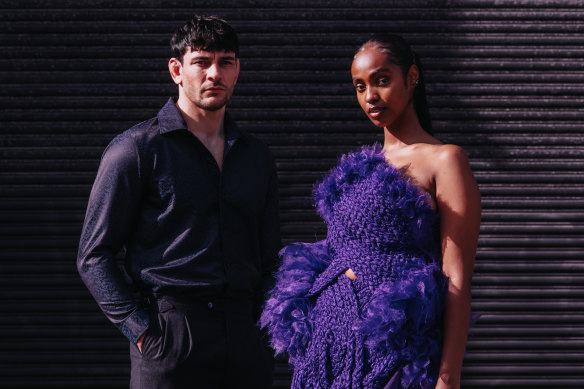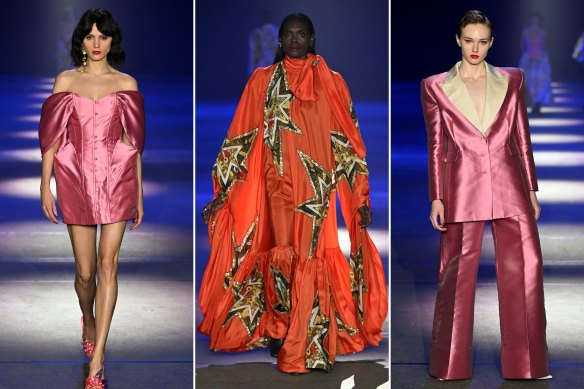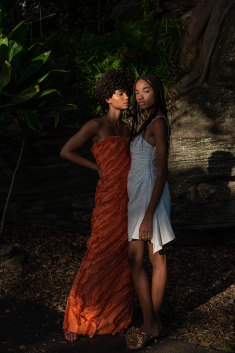The new ‘rules’ of formal dress bend the codes, without breaking them
Save articles for later
Add articles to your saved list and come back to them any time.
Fashion designer Christian Kimber wouldn’t necessarily liken himself to celebrity chef Heston Blumenthal, British heritage notwithstanding. But just as Blumenthal is known for his “meat fruit” – where he disguises pate to look like ripe mandarins – Kimber is dabbling in optical illusions to challenge the “rules” of dressing formally.
Where tuxedos and dinner jackets are normally crafted from wool (or polyester, among more budget-conscious brands), Kimber’s first foray into formal attire at Australian Fashion Week – he has done custom dinner suits for clients, but this is more expansive – will include bow ties paired with linen trousers, and blazers in fabrics and textures outside the black tie norms.
Code switching … models Markus Galloway, wearing Christian Kimber, and Reem Elbour, wearing Youkhana.Credit: James Brickwood
“Menswear has changed – if you’re going to wear a suit now, maybe it’s more special, something more exciting, maybe you push it a bit,” Melbourne-based Kimber says.
In the post-lockdown era, a duality has emerged: events have returned en masse, and many of them are attracting formal dress codes (sometimes unjustifiably); and people are dressing more for an occasion, even a feeling, than to a prescribed code.
Stylist Karla Clarke says the looser rules give more freedom, but also more, perhaps even too much, choice. She says event dressing has sadly become quite uniform, “homogenised, and in black”, and welcomes a bending, not a breaking, of the rules.
“Black tie in Australia doesn’t mean ‘black-black’ tie – we’re a bit more relaxed, and people just don’t know what it really means,” she says. “[Most people] wouldn’t know it means not seeing an ankle [on women].”
That maxim was well and truly smashed on day one of fashion week, when Alemais opened the week with a feast of formal looks that leaned heavily into disco with a touch of Alice in Wonderland surrealism.
Alemais looks on the runway at Australian Fashion Week.Credit: Getty
Edwina Forest of mega-brand Aje has captured the Australian party aesthetic better than most over the past 15 years with some of her design signatures: a puffed sleeve here, a cut-out or hand-painted print there.
‘Undone’ effect … models Shantae Leslie (left) and Lenny Nunes in Aje.Credit: Flavio Brancaleone
The brand’s 15th-anniversary collection, to be shown on Tuesday at Sydney Modern, will undoubtedly include several showstopping dresses. But even the most formal pieces carry a sense of “undone”, which Forest says stops them from being too stiff or limiting their wearability.
“They’re pieces you can get away with wearing again but also feel unique … and make a statement without being too loud or overwhelming,” she says.
Old ideas of formal wear, particularly the notion of wearing a garment only once, are as outdated as dress codes themselves, Forest says. “I don’t think it’s financially something many [customers] can afford, but also the lifestyles we lead necessitate these pieces must last for longer.”
As for hosts scattering black tie dress codes around like confetti, Clarke has some choice words: if the venue doesn’t warrant it, don’t do it. “A dress code is one part of an event. But everything has to be at the same level.”
Former hairdresser turned designer Nathaniel Youkhana, who showed his collection on Monday, says contemporary formal dress is more about an attitude or level of sophistication than strict criteria. “It can mean anything from secondhand dresses and vintage designer blazers paired with tailored pants or skirts and vintage shoes, to bowties and made-to-measure ensembles, or even full-length couture gowns. Ultimately, the definition of formal wear is entirely subjective,” the 32-year-old says.
Kimber agrees more clients are coming to him with an occasion, or destination in mind, and asking for an outfit that fits. He says his new collection, which adds his signature “elevated casual” twist to formal dress, is very much derived from requests from his customers.
His advice? Take a risk with one item, be it a bold jacket or pant, and keep the rest relatively neutral. “There has always been this idea of recreating what evening wear is, breaking those rules, bringing colour into it. But still doing it in an elegant way – that’s the key.”
Make the most of your health, relationships, fitness and nutrition with our Live Well newsletter. Get it in your inbox every Monday.
Most Viewed in Lifestyle
From our partners
Source: Read Full Article


